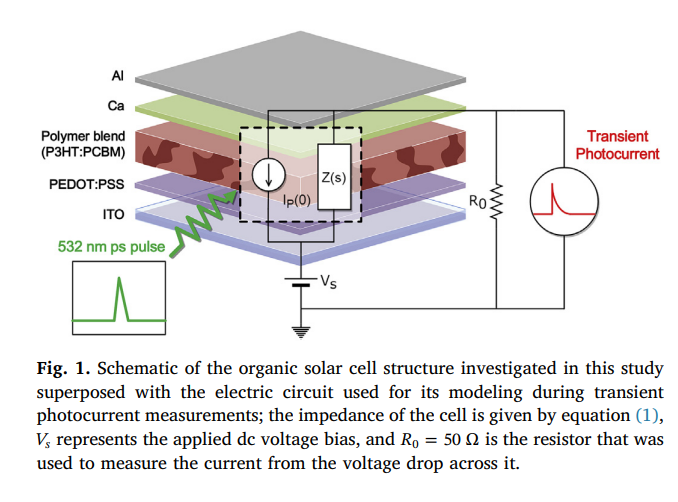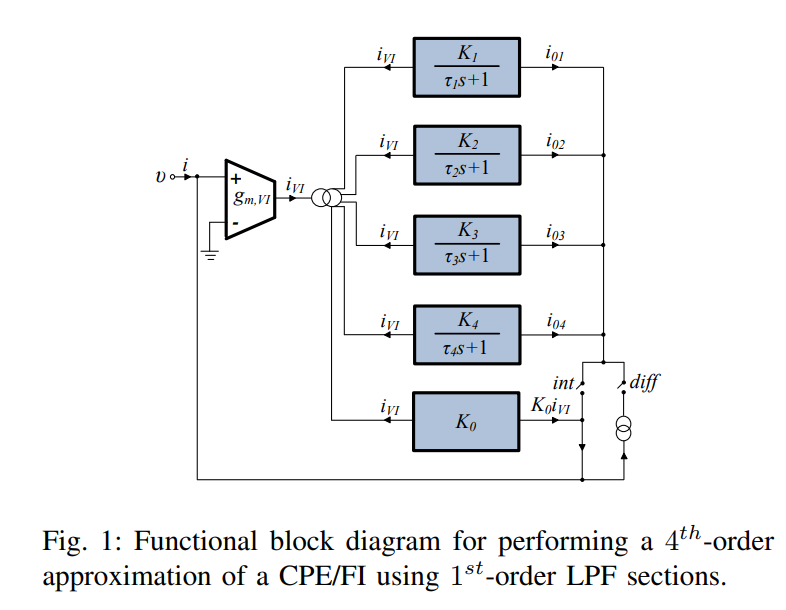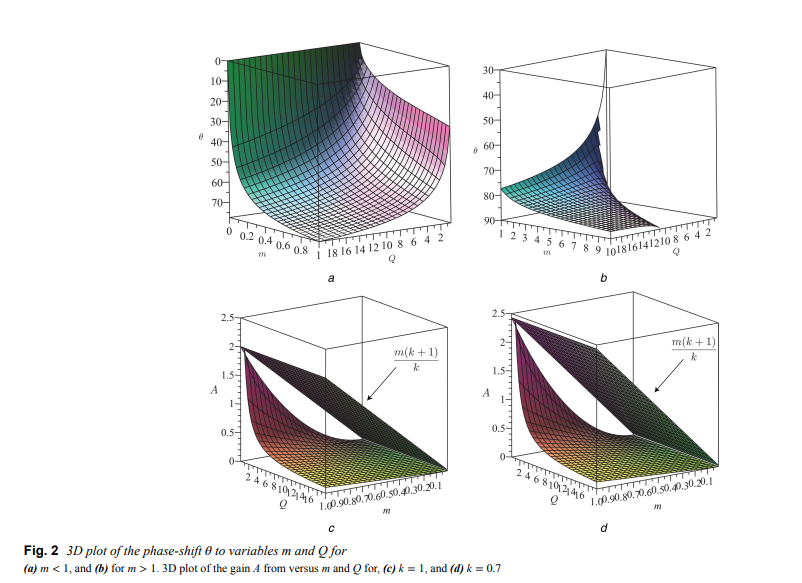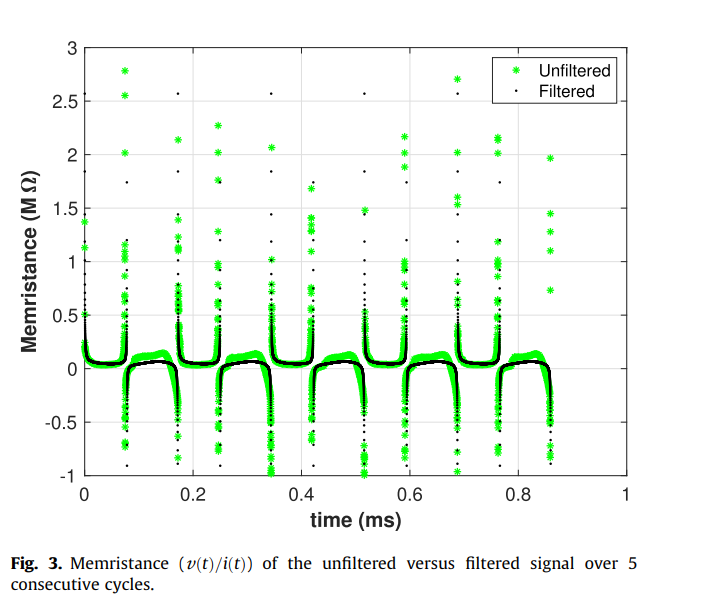Breadcrumb

The minimax approach for a class of variable order fractional differential equation
This paper introduces an approximate solution for Liouville-Caputo variable order fractional differential equations with order 0

On the modeling of dispersive transient photocurrent response of organic solar cells
The current methods used for estimating the electrical parameters of organic solar cells (OSC) from time-domain measurements are based on integer-order impedance models. Meanwhile, in the frequency-domain, the adopted circuit models usually contain a constant phase element which is known to capture effectively the fractional-order dispersive behavior of these devices. Therefore, inconsistency arises between the two analyses. In this work, we derive the time-domain relaxation response of an OSC, found to follow a Mittag-Leffler function, using the same fractional-order impedance model. The

Log-domain implementation of fractional-order element emulators
Novel fractional-order capacitor and inductor em-ulators are presented in this work, which offer fully electronic tunability of their characteristics and, simultaneously, reduced circuit complexity compared to those already introduced in the literature. This has been achieved through the utilization of the log-domain filtering for implementing the approximation of the required fractional-order differentiation/integration stages. The behavior of the presented topology is evaluated using the Cadence software and MOS transistor models provided by the 0.35μm Austria Mikro Systeme CMOS process. ©

An Ultra-Low Power Wide-Band Single-Transistor Second-Order Allpass Filter in 65nm CMOS
In this paper, we propose a MOS design of a second-order voltage-mode allpass filter to be used as a time delay cell. The proposed filter is based on a single transistor, three resistors and two energy storage elements and was designed in a 65nm CMOS technology. Post-layout simulations demonstrate a group delay of approximately 13ps across a 30GHz bandwidth, while only consuming 809.7μW from a 1-V supply. As a proof of concept, the proposed filter was constructed and verified experimentally using discrete MOS transistors. The experimental results show a group delay of approximately 370ns
Single-Transistor Second-Order Allpass Filters
This paper presents two CMOS designs of a second-order voltage-mode allpass filters (APFs) for high-frequency applications. Each of the proposed filters is based only on a single transistor and four surrounding impedances. The first proposed allpass filter is an RL filter while the second proposed one is an RLC filter. A detailed analysis along with the parasitic effects is provided for each of the proposed filters. As a proof of concept, one design was constructed and verified experimentally using discrete MOS transistors at a 2.3MHz pole frequency. The experimental results showed a group

Third-order tunable-phase asymmetric crosscoupled oscillator
Here, the authors show that an asymmetric cross-coupled oscillator can be used to achieve independent-phase tunable outputs. In particular, a third-order cross-coupled oscillator, with non-balanced loads, is studied and expressions for its start-up condition, oscillation frequency, phase-shift between its two outputs as well as their amplitude ratio are derived. From these expressions, it is found that independent tuning of these design specifications is possible and a voltage-controlled phasetunable oscillator can be achieved. As a consequence of the non-balanced loads, the tail biasing

On the mechanism of creating pinched hysteresis loops using a commercial memristor device
In this short communication we analyze the impact of signal harmonics on the formation of the pinched hysteresis loop using a commercial memristor device. We show that by using only the fundamental frequency and the second harmonic components, extracted from the measured electrical current signal, a distortion-less pinched hysteresis loop is re-created. This loop is then used to simulate memristor-based AND/OR gates without any loss in digital functionality. This verifies that the generation of a pinched hysteresis loop requires a nonlinear frequency doubling mechanism to create a second

8-GHz low-power voltage-mode second-order allpass filter in 65-nm CMOS
In this paper, a CMOS wide-band low-power second-order voltage-mode allpass filter design is proposed as a true time delay element. The proposed allpass filter core design consists of a single transistor, three resistors, one capacitor and one inductor. As a time delay element, the proposed circuit exhibits a group delay of 34 ps within a bandwidth of 8 GHz while consuming only 926 μW from a 1-V supply voltage. The proposed filter was designed in 65-nm CMOS technology and verified through post-layout simulation results. © 2019 IEEE.

Quantification of memory in fractional-order capacitors
In this study we quantify and interpret the inherent memory in fractional-order capacitors when subjected to constant current charging/discharging waveforms. This is done via a finite difference approximation of the fractional order rate equation I(t) = Cαdαv(t)/dtα (0 le; α ≤ 1) relating current to voltage in these devices. It is found that as the fractional exponent α decreases, the weight of the voltage memory trace that results from the contribution of past voltage activity increases, and thus the measured response of the device at any time is increasingly correlated to its past. Ideal

Generalized Fully Adjustable Structure for Emulating Fractional-Order Capacitors and Inductors of Orders less than Two
A novel scheme suitable for the emulation of fractional-order capacitors and inductors of any order less than 2 is presented in this work. Classically, fractional-order impedances are characterized in the frequency domain by a fractional-order Laplacian of the form s± α with an order 0 < α< 1. The ideal inductor and capacitor correspond, respectively, to setting α= ± 1. In the range 1 < α< 2 , fractional-order impedances can still be obtained before turning into a Frequency- Dependent Negative Resistor (FDNR) at α= ± 2. Here, we propose an electronically tunable fractional-order impedance
Pagination
- Previous page ‹‹
- Page 6
- Next page ››
